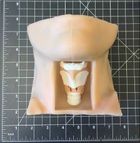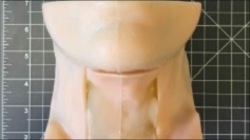DAS Project Grant
Please click the arrow to view abstract
Creation and validation of anatomically correct cricothyroidotomy models for training by 3-D printing
Dr Paul Fennessy
Cricothyroidotomy is an emergency procedure used by doctors and paramedics to provide oxygen to critically unwell patients when it cannot be provided any other way. This is performed by creating a hole in the front of the patient's neck and placing a breathing tube through it. While it is a rare event, it is crucial that providers are sufficiently well trained to perform this procedure in an emergency. Unfortunately, recent research has shown that it often fails to achieve its goals. Because of its rarity, training is normally performed using 'dummies' or medical mannequins, which by and large are overly simplistic in so far as they are based on an anatomy considered to be 'easy.' The reality is that the real life scenario is more likely to occur in an individual patient whose anatomy is difficult such as an obese person whose neck structures are hard to palpate. Therefore it is desirable to create a realistic training model, which allows emergency personnel to practice this procedure in models based on real and challenging human anatomy, which is far closer to the scenario they are likely to encounter in clinical reality.
We have already developed and hope to further refine and validate such an anatomically correct training model. We have, following appropriate permissions, used existing scans created electronic maps of human throat structures (the larynx) and 3-D printed them in normal dimensions. We have deliberately chosen a 'difficult' and an 'easy' case for initial testing. We have embedded these structures into inserts, which we placed in an artificial neck also recreated from existing scans (see figure 1)
Figure 1 Prototype Model
3-â€D printed larynx in neck
(Support tissues removed for illustration)

Modular insert in neck

We have performed pilot studies of our models by asking doctors to assess how realistic the models are. We also asked them to perform the emergency procedure (cricothyroidotomy) using the recommended approach to see how the models perform. On the basis of these preliminary studies we are happy that the 'easy' model performs well but we wish to further refine the 'difficult' model until its performance is closer to what we expect in real life based on work we have already done. These validation studies are done in a laboratory type environment for which all relevant permissions have been granted.
Once we have satisfactorily established that our models work we propose to make it available for 3-â€D print by using open source software, which means that an interested party can download the 'map' and use their own 3-â€D printer to replicate our model.







